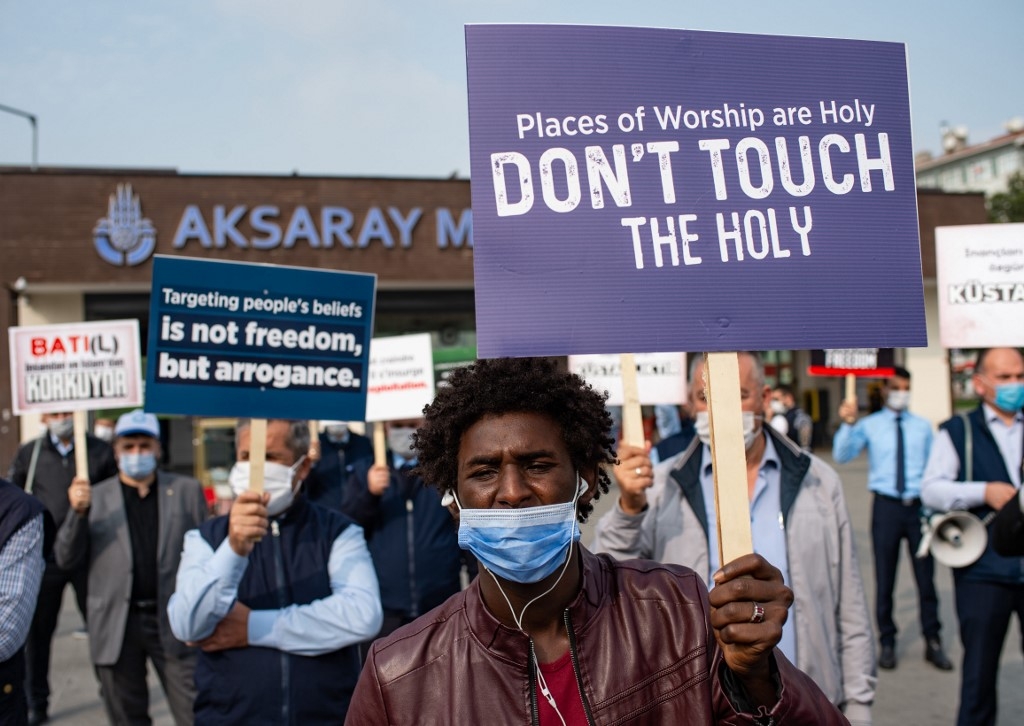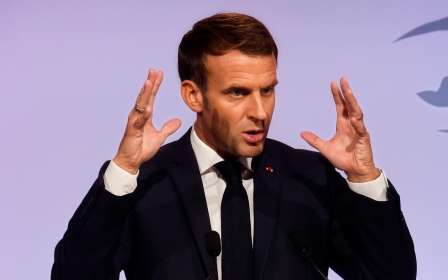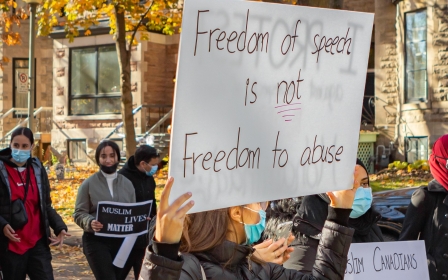How cartoons of the Prophet Muhammad mark a return to the propaganda of the Middle Ages

France, and indeed the whole world, were rightly shocked by the barbarous murder in October of schoolteacher Samuel Paty at the hands of an 18-year-old Muslim refugee from Chechnya. The alleged reason for the crime was that Paty, while teaching his students about free expression, showed infamous cartoons denigrating the Prophet Muhammad.
That horrendous crime was quickly followed by an even more brazen one: the murder of three people inside the Notre-Dame cathedral in Nice.
France, instead of taking targeted measures against the guilty parties and those who might have aided them, has instead gone down the now all-too-familiar path of blaming what it believes is an unreformed Islam and a backwards Muslim community. It stands on the cusp of adopting sweeping legislation that, while broadly threatening the civil rights of all of its citizens, will undoubtedly impact Muslims most negatively.
Central trope of Islamophobes
These responses come against the backdrop of President Emmanuel Macron declaring that Islam is “in crisis all over the world”, and that his government would launch an aggressive campaign to combat what he calls “Islamist separatism”. In justifying his muscular approach towards Islam (and not just towards Muslims who commit acts of violence), Macron sees himself as defending the ideals of the Enlightenment and sharing them with the benighted Muslims of France.
New MEE newsletter: Jerusalem Dispatch
Sign up to get the latest insights and analysis on Israel-Palestine, alongside Turkey Unpacked and other MEE newsletters
There is substantial evidence that an important number of prominent European intellectuals of the Renaissance and the Enlightenment were, if anything, Islamophiles
Contrasting the “enlightenment” of Europe with the “barbarism” of Islam is a central trope of Islamophobes, whether in Europe or North America. Yet, this dichotomy could not be further from the historical truth surrounding Europe’s Enlightenment, and even its Renaissance. Both were characterised by a repudiation of the fanatic hatred of Islam and Muslims that the church in the Middle Ages had preached, in favour of a much more balanced appreciation of Islam and the Prophet Muhammad.
Indeed, there is substantial evidence that an important number of prominent European intellectuals of the Renaissance and the Enlightenment were, if anything, Islamophiles.
Two recently published books confirm this point. The first is Faces of Muhammad, a book that narrates how European perceptions of the Prophet Muhammad evolved from the figure of the crude imposter propagated by the Catholic church during the Crusades to a religious reformer, glorious leader, and anti-clerical hero to many figures in the Reformation and the Enlightenment.
Transformative effects
For Americans, the Enlightenment tradition of honouring the Prophet Muhammad manifested itself in his presence in a frieze at the Supreme Court honouring the great lawgivers of mankind.
The author of Faces of Muhammad, historian John Tolan, notes that the rise of humanism through the Renaissance and the Enlightenment allowed Europeans to begin to appreciate the Prophet Muhammad as a historical figure of immense significance, rather than simply as a threat to the church.
In addition, English historian Noel Malcolm’s recent book, Useful Enemies, chronicles the transformative effects that the Ottoman Empire and Islam had on European political imagination.
European travellers to Ottoman territories in the 15th and 16th centuries, despite the often crude anti-Ottoman and anti-Muslim propaganda that prevailed in Europe, were duly impressed by the empire’s religious tolerance; the orderliness and security of its cities; its highly disciplined military; the civic spirit of its well-to-do citizens; a reasonably effective, impartial and speedy judicial system; its reliance on merit as the metric for promotion; and the independence of the state from the religious class.
The increasing encounters of Europeans with the Ottomans and the Mamluks, at least until the conquest of Egypt and Syria in the first quarter of the 16th century, left their traces among the most important European political thinkers of the Renaissance, including the celebrated Florentine political writer Niccolo Machiavelli and the French political theorist Jean Bodin. France played an especially important role as a site for resistance to crude depictions of Islam by virtue of the alliance between Ottoman Sultan Suleyman the Magnificent and French King Francis I.
Catholic backlash
These positive encounters with Islam and Muslims in turn inspired European thinkers to imagine ways in which they could transform their own societies. So great was the attraction of the Ottoman model to 16th-century European political writers that, according to Malcolm, it produced a backlash at the hands of Catholic intellectuals, who sought to shore up support for the Hapsburgs in their struggle against the Ottomans.
Their campaign led to the invention of the trope of Oriental despotism in an attempt to subvert the attractiveness of the Ottoman Empire in the eyes of Europeans.
The values of the Renaissance and the Enlightenment amounted to a repudiation of traditional Christian hostility towards Islam and its Prophet
What these two books unequivocally demonstrate is that the values of the Renaissance and the Enlightenment amounted to a repudiation of traditional Christian hostility towards Islam and its Prophet, and the adoption of a spirit of respect - and even admiration - in its place.
While certain conceptions of freedom of expression might compel a state to permit denigrating portrayals of the Prophet Muhammad to be circulated freely (although anyone with knowledge of French law knows that this is not true for France), in no way can such images be viewed as compatible with the ideals of the Enlightenment; rather, they represent an atavistic return to the crudest propaganda of the Middle Ages, and deserve to be so treated.
The views expressed in this article belong to the author and do not necessarily reflect the editorial policy of Middle East Eye.
Middle East Eye delivers independent and unrivalled coverage and analysis of the Middle East, North Africa and beyond. To learn more about republishing this content and the associated fees, please fill out this form. More about MEE can be found here.






